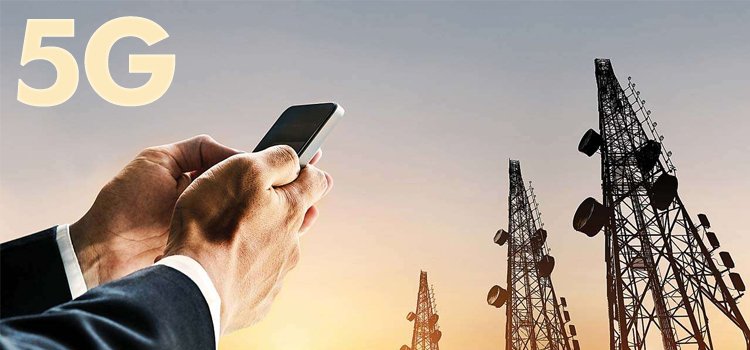INDUSTRY
A Brave New World: 5G services set to take India closer to $5-trillion economy
- IBJ Bureau
- Oct 21, 2022

On
October 1, Prime Minister Narendra Modi launched 5G mobile services in the
country at the India Mobile Congress (IMC) in New Delhi’s Pragati Maidan. With
this launch, India has joined a privileged league of 70 countries with 5G
mobile services.
Bharti
Airtel launched 5G services at the IMC and became the first telecom company in
the country to rollout out the advanced facility. Bharti Airtel’s 5G services
will initially be available in eight cities – Delhi, Mumbai, Chennai,
Bengaluru, Hyderabad, Siliguri, Nagpur and Varanasi. The telecom company has
said that will expand its 5G network across urban India by 2023.
“We
need to install some equipment on mobile towers for 5G service. We are doing it
gradually. As of today, the service will be available in the area close to
towers where the equipment has been installed,” Bharti Airtel Chief Technology
Officer Randeep Singh Sekhon has said.
Days
later, coinciding with Deepavali, Reliance Jio (RJio) unveiled its 5G facility across
the four metros of New Delhi, Mumbai, Kolkata and Chennai. Reliance Industries (RIL)
Chairman and Managing Director Mukesh Ambani has revealed that RJio will bring
5G services to all Indians by December 2023.
RJio
has committed a total investment of over Rs 2,00,000 crore to build a pan-India
5G network. Unlike other operators, RJio`s 5G network will be standalone with
zero dependency on 4G network. Experts indicate that RJio’s standalone 5G
architecture will enable the largest and best mix of spectrum and help offer an
unparalleled combination of coverage, capacity, quality and affordability.
Vodafone
Idea, the country’s third-largest mobile, has disclosed that it will roll out
its 5G sevices soon. However, the telecom has not specified a launch date or a coverage
timeline.
Unlike
the past mobile spectrum auctions, the 5G auctions, which had concluded in
August, were relatively successful, having mopped up record Rs 1,50,000 crore
of bids. The auction had witnessed sale of 51,236 mhz, accounting for 71 per
cent of the 72,098 mhz offered across 10 bands. RJio had cornered nearly half
of all the airwaves sold with a Rs 88,078-crore bid. Bharti Airtel and Vodafone
Idea had bought spectrum worth Rs 43,084 crore and Rs 18,799 crore respectively.
5G’s Top Gains
- Better
and clear coverage of mobile services
- Wide coverage in remote areas
across the country
- Seamless
and uninterrupted data consumption
- Advanced
gaming apps and a number of other immersive activities
- A
vital role in making India a $5-trillion economy
- Facilitating further penetration of AI and ML
- AR
and VR set to transform education, health, agriculture, logistics,
manufacturing and all other sectors
- A boost to digital wallets, smart homes and better connected lifestyle
Big impact
5G
is set to provide a transformational experience for mobile phone users. 5G
offers better coverage and clarity with advanced technology and highly-reliable
communication system. A higher internet speed of around 10 gbps (gigabytes per
second) – compared with 100 mbps (megabytes per second) of 4G – and latency as
low as 1 millisecond (ms) – time taken by a device to send data and get
response – will offer customers seamless and uninterrupted data consumption.
With a 5G facility, customers can watch 4K videos on their phones. They will
also be able to experience augmented reality (AR) and virtual reality (VR), use
advanced mobile gaming apps and indulge in a number of other immersive
activities and new applications.
The
new technology will provide seamless coverage in remote areas across the
country. It will increase efficiency of energy, spectrum and network. “The
government is investing $30 billion (around Rs 2,50,000 crore) in 4G, 5G and a
robust digital infrastructure in rural India to ensure last-mile network
accessibility for 4G and 5G in every village across the country and build a
robust digital infrastructure in the rural areas,” Union Information Technology
Minister Ashwini Vaishnaw has said.
5G
services are expected to play a major role in achieving the economic goal of
making India a $5-trillion economy. According to experts, 5G will have a
cumulative economic impact of $1 trillion by 2035 and can deliver an additional
GDP of $150 billion for the country between 2025 and 2040.
“Telecom
is a gateway of Digital India. Telecom is the root of all digital services that
we are seeing in our modern life. 5G services will bring fundamental change in
several sectors – education, health, agriculture, logistics and banking. It
will create new opportunities,” Mr Vaishnaw adds.
The
new generation of airwaves have the potential of connecting billions of devices
and sharing information in real time. It will also help in the fields of
artificial intelligence (AI) and machine learning (ML) as scientists will be
able to program more data into systems. By using VR, AR, Internet of Things
(IoT) and other modern technologies, 5G can enable end-to-end effects on
multiple sectors, such as healthcare, agriculture, education, disaster
management and so on.
New
business models designed around 5G can facilitate growth across diverse sectors
and have a multiplier effect on the economy. The new technologies can spur advanced
digital wallets, vehicle-to-vehicle communication, smart homes and appliances
for better connected lifestyle.
“Students
from different backgrounds would be able to participate in classes in real time.
Agriculture can have the entire value chain, from precision farming, smart
irrigation, improved soil and crop monitoring, to livestock management. In the
energy sector, smart grids and smart metering can be supported,” points out Pranav
Srivastava, a partner of law firm Phoenix Legal.
There
can be a higher degree of adoption of Industrial Revolution 4.0, driven by 5G
technology. The new class of spectrum can connect sensors and devices of
various types of machines and automate various processes of manufacturing. “I
often say that 5G is like the last piece of the Industry 4.0 jigsaw puzzle that
will spearhead the next wave of digital disruption, taking us a step closer to
realising our dream of Aatmanirbhar Bharat and technological supremacy,” notes Tech
Mahindra President (Communications, Media and Entertainment Business) and CEO (Network
Services) Manish Vyas.
The
next-generation of 5G technologies will have an impact on how goods are produced
and distributed across supply chains. Application of the new processes will reduce
costs, lower down time, facilitate minimum wastage and improve productivity. 5G
is expected to bring down the cost of logistics from 14 to 5 per cent.
The
new set of technologies has the potential to transform the transport and
mobility sector. Using 5G, a network of electric vehicles (EVs) and charging
stations can be established to help maximise the cost-effectiveness of the EV
ecosystem. The 5G network will also aid working from a remote location more
effectively. 5G-powered smart buildings can help provide more comfortable
working environment for employees, boosting productivity along with reducing
costs for employers.
Perhaps
one of the biggest gainers from 5G would be the education sector. Schooling at
primary and secondary levels, especially in remote, rural areas, will see
drastic improvement with better connectivity as it will allow rapid
interactivity and connectivity with multiple devices.
5G
services will have a big impact in the safety and surveillance sector. The new technologies
and their applications will enable remote control over disaster-hit areas and
live 4K feed from HD cameras installed in public spaces. It can also help in
minimising the role of humans in dangerous industrial operations, such as deep
mines and offshore activities, among others.
Hospitals
can leverage 5G services to track medical devices and patient beds to trigger
actions automatically. These services can accelerate patient handovers, remote
robot-assisted surgeries and other operations across the healthcare sector.
Major Interruptions
- Likely higher tariffs and costly 5G-compliant
handsets
- A game-changing, Rs-10,000 5G handset still at least
a year away
- A severe shortage of semiconductor chips further
complicating matters
- Weakening rupee and rising component costs making
handsets costlier
- Concerns over roaring inflation and recession seriously
dampening consumer spending
- A low level of fibre deployment leading to higher expenditure on 5G infrastructure
Hurdles ahead
India has entered the world of 5G and is set to reap
its benefits. However, the country will have to overcome a few hurdles before
the gains of 5G begin accruing. One of the biggest challenges in the way of 5G
technology gaining popularity and widespread adoption is affordability.
For now, both Bharti Airtel and RJio have not put
out separate tariffs for 5G services, keeping them on a par with 4G services.
But as time goes by and volume of 5G users rises, the telecom operators may
price them at a higher rate. Likely higher tariffs for 5G are not a major
concern. The bigger worry is current cost of 5G-compliant handsets.
The average selling price of 5G smartphones has
escalated this year. A good, entry-level 5G smartphone costs anywhere between
around Rs 14,000 and Rs 16,000. This price tag would dissuade a large number of
people, who would otherwise be eager to use 5G services. A Rs-10,000 5G handset
can be a game-changer that will expedite usage of 5G. However, a 5G handset at
Rs 10,000 is at least a year away, point out analysts tracking the telecom
sector.
Besides, a lot of developments in the past one year,
especially after COVID-19, have been adding to the cost of high-end devices,
including smartphones. A severe shortage of semiconductor chips has propelled
prices of 5G handsets. Moreover, weakening of the rupee against the dollar and
rising component costs have added to surging prices of smartphones. Add to it,
concerns over roaring inflation and economic uncertainty amid fears of
recession engulfing most parts of the world are seriously dampening consumer
spending.
Meanwhile, a recent survey by Ookla – the US-based
company that measures speed, access and other parameters of internet services –
confirms the worst fears of analysts. The survey, conducted in India, reveals
that perceived costs of 5G tariffs and 5G-capable phones are the primary reasons
for people to stay away from adopting 5G services.
Infrastructure deployment is seen as another
critical factor that may hamper speedy deployment of 5G services. Analysts
estimate that the telecom industry would need about Rs 2,50,000 crore of investment
in infrastructure in the next two years for a meaningful rollout of 5G services
across the country. They point out that a low level of India’s fibre deployment
is the main reason for the higher expenditure on infrastructure.
Huge
potential
Despite some concerns, the long-term outlook for 5G
services in the country is quite promising. India is the world’s second-largest
mobile phone market, next only to China. Around 65 crore of the over 100 crore
Indian mobile customers use smartphones. Analysts estimate that around 10 per
cent of the creamy layer of 4G smartphone users may shift to 5G initially. This
number too is quite large to begin with.
Moreover, the number 5G users will considerably rise in future as the cost of 5G hardware decreases and technology and vendor ecosystem continue to mature. The potential for higher growth of smartphone users is very well assured, given that about 35 crore Indians are still using feature phones. As the cost of handsets and future tariffs comes down, a large part of the feature phone users may directly migrate to 5G services.
“The internet today represents a far more economically-valuable aspect of our lives than it was 10 years ago. Around 1.2 billion Indians are going to be using the internet in the next two years through 5G and BharatNet,” predicts Minister of State for Information Technology Rajeev Chandrasekhar. The minister’s prediction may easily materialise earlier than estimated, leading to a large number of 5G phones ringing aloud.
























Report By
View Reporter News